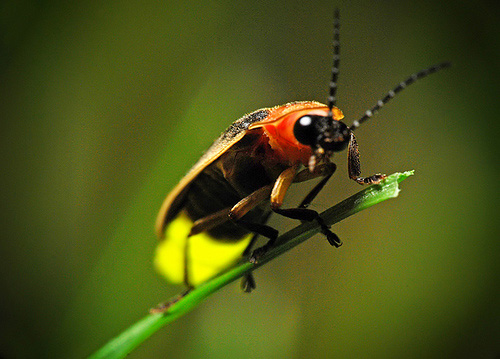By Mike Weilbacher, Exec Director
Saw my first firefly just last week, right after Memorial Day. For me, a naturalist who marks the passage of time by nature’s calendar, nothing says summer like an evening of fireflies.
And one of my favorite stories is the secrets of a firefly’s flash.
When you see a cloud of fireflies rising from your lawn like liquid lightning, you are witnessing a stag party, a collection of horny males desperately seeking Susans– every firefly flashing around you is male, the flash used to seduce a female into responding. Firefly females are generally flightless, their abdomens too weighted down with the machinery of egg production.
Males seek them out by strafing the grasses, cruising tree branches, looking for female perching spots—flashing females in both senses of the word.
And each firefly species has its own unique flash pattern– its own Morse code– which one species uses distinguishes itself from another. So the firefly flashing in a J-pattern is a separate species from one flashing two dashes, though both appear identical to the untrained eye. In some cases, even the best microscopes can’t tell discern one species from another, but they know who is who. And who is where. Some species flash high, others flash low: fireflies sort out species by both pattern and space.
For every male’s flash, there is a correct answer, perhaps a two-second pause and then a quick, surreptitious dash. The males flash questions into the night air, hoping (if insects truly hope) for an answer to appear from below.
Then the story gets knotty. There is a species of firefly the female of which also has decoded the correct response to another species. When she’s interested in mating, she answers the male with the appropriate answer, and sex ensues. But when she’s hungry, she searches for the flash of the other, and gives that one’s appropriate response. That male lands thinking he’s about to mate, and the female happily devours him, getting the protein she needs to create a batch of eggs.
One helluva way to leave this world.
That’s the why of firefly flashing. Like a butterfly’s bright colors, a house wren’s bubbly song, a cricket’s scratchy chirrup, and a deer’s horny antlers, a firefly’s light is a neon sign, advertising its species, its sex, and its availability.
The how is different: a firefly’s abdomen is loaded with a pair of chemicals, luciferin and luciferase, held in separate sacks. When exposed to each other, a powerful chemical reaction occurs that releases large amounts of energy as light, a light that magically generates infinitesimally small amounts of heat (unlike, say, a light bulb). This bioluminescence is astonishingly common under the sea, where everything from single-celled dinoflagellates (a kind of plankton) to large bony fish glow in the ocean. On land, however, bright life is exceedingly uncommon.
In the tropics, where the forests are dense, fireflies can’t see or find each other in the growth. There, flashing fireflies migrate to river corridors, and cover trees by the thousands– all flashing synchronously, the entire forest along a riverbank beckoning to firefly females to come closer.The flash of a firefly is a short-lived phenomenon– only a few weeks centered on the summer solstice, their bright lights marking the beginning of summer.
One firefly-filled night soon, open a bottle of wine, lure your spouse onto the deck or the porch, witness the wonder of thousands of insects glowing all around you, whisper in his or her ear the full story of the firefly’s flash– and see what else develops that night.
Special Event: Join me for Firefly Nights, the first in our new Nature Uncorked series of events. We’ll enjoy a wine and cheese reception in our firefly meadow while learning the natural history of these, and other, evening critters. Nature Uncorked is $10/event (member price), $25 for the series of three. Pre-registration required! Register on our web site, schuylkillcenter.org.

